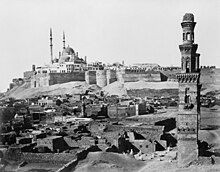Cairo Citadel








The Saladin Citadel of Cairo (Arabic: قلعة صلاح الدين Qalaʿat Salāḥ ad-Dīn) is a medieval Islamic fortification in Cairo, Egypt. The location, on Mokattam hill near the center of Cairo, was once famous for its fresh breeze and grand views of the city. It is now a preserved historic site, with mosques and museums.
Medieval history
The Citadel was fortified by the Ayyubid ruler Salah al-Din (Saladin) between 1176 and 1183 CE, to protect it from the Crusaders.[1] Only a few years after defeating the Fatimid Caliphate, Saladin set out to build a wall that would surround both Cairo and Fustat. Saladin is recorded as saying, "With a wall I will make the two [cities of Cairo and Fustat] into a unique whole, so that one army may defend them both; and I believe it is good to encircle them with a single wall from the bank of the Nile to the bank of the Nile." The Citadel would be the centerpiece of the wall. Built on a promontory beneath the Muqattam Hills, a setting that made it difficult to attack, the efficacy of the Citadel's location is further demonstrated by the fact that it remained the heart of Egyptian government until the 19th century.[2] The citadel stopped being the seat of government when Egypt's ruler, Khedive Ismail, moved to his newly built Abdin Palace in the Ismailiya neighborhood in the 1860s. While the Citadel was completed in 1183–1184, the wall Saladin had envisioned was still under construction in 1238, long after his death.
To supply water to the Citadel, Saladin built the 280 feet (85 m) deep[3] Well of Joseph (so-called because Saladin's birth name, Yūsif, is the Arabic equivalent of Joseph), which can still be seen today. This well is also known as the Well of the Spiral because its entrance consisted of 300 stairs that wound around the inside of the well. Once water was raised from the well to the surface, it traveled to the Citadel on a series of aqueducts. During the reign of al-Nasir Muhammad, the Well of Joseph failed to produce enough water for the numerous animals and humans then living in the Citadel. To increase the volume of water, Nasir built a well system that consisted of a number of water wheels on the Nile, the water from which was then transported to the wall and subsequently to the Citadel, via the aqueducts Saladin had constructed.
The improvements to the Citadel's water supply were not Nasir's only additions to the Citadel, which was subject to a number of different additions during the Mamluk period. Nasir's most notable contribution was the Mosque of Nasir. In 1318 Nasir rebuilt the Ayyubid structure, turning it into a mosque in his name. The structure underwent further additions in 1335. Other contributions to the Citadel during Nasir's reign include the structure's southern enclosure (the northern enclosure was completed by Saladin) and the residential area, which included space for the harem and the courtyard. Prior to Nasir's work on the Citadel, the Baybars constructed the Hall of Justice and the "House of Gold."[2]
19th-century history
The Citadel is sometimes referred to as Mohamed Ali Citadel (Arabic: قلعة محمد علي Qalaʿat Muḥammad ʿAlī), because it contains the Mosque of Muhammad Ali of (or Mohamed Ali Pasha), which was built between 1828 and 1848, perched on the summit of the citadel.[4]
This Ottoman mosque was built in memory of Tusun Pasha, Muhammad Ali's second son who died in 1816. However, it also represents Muhammad Ali's efforts to erase symbols of the Mamluk dynasty that he replaced. When Ottoman ruler Muhammad Ali Pasha took control from the Mamluks in 1805 he altered many of the additions to the Citadel that reflected Cairo's previous leaders. One obvious change that Muhammad Ali enacted pertained to the uses of the Citadel's northern and southern enclosures. During the Mamluk period the southern enclosure was the residential area, but Muhammad Ali claimed the northern enclosure as the royal residence when he took power. He then opened the southern enclosure to the public and effectively established his position as the new leader.[5]
The mosque is the other feature of the Citadel that reflects the reign of Muhammad Ali. This feature, with its large dome and overtly Ottoman influenced architecture, looms over the Citadel to this day. Recently destroyed Mamluk palaces within the Citadel provided space for the formidable mosque, which was the largest structure to be established in the early 19th century. Placing the mosque where the Mamluks had once reigned was an obvious effort to erase the memory of the older rulers and establish the importance of the new leader. The mosque also replaced the mosque of al-Nasir as the official state mosque.[4]
There are two other mosques at the Citadel, the 14th-century hypostyle Al-Nasir Muhammad Qala'un Mosque[6] from the early Bahri Mamluk period, and the 16th-century Mosque of Suleyman Pasha, first of the Citadel's Ottoman-style mosques.
Museums
The citadel also contains museums:
- Al-Gawhara Palace museum
- Carriage Museum
- Egyptian Military museum
- The Egyptian Police Museum.
References
- ^ Ades, Harry (2007). A Traveller's History of Egypt. Arris Publishing Ltd. p. 226. ISBN 1-905214-01-4.
- ^ a b Raymond, Andre (2001). Cairo. trans. by Willard Wood. Harvard University Press. pp. 85–132.
- ^ Ripley, George; Dana, Charles A., eds. (1873). "Cairo". American Cyclopaedia. D. Appleton And Company.
- ^ a b "The Mosque of Muhammad Ali (history)".
- ^ Dunn, Jimmy (2006-04-07). "The Citadel in Cairo". Touregypt.net. Retrieved 2012-03-28.
- ^ Ades, Harry (2007). A Traveller's History of Egypt. Arris Publishing Ltd. p. 237. ISBN 1-905214-01-4.
